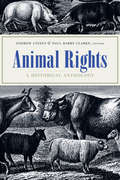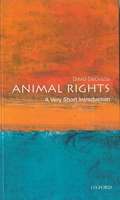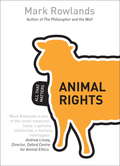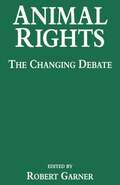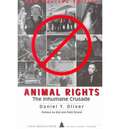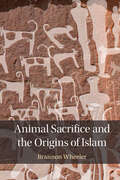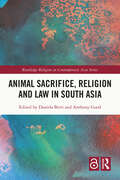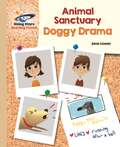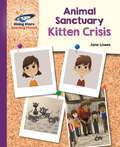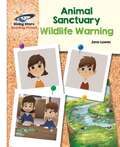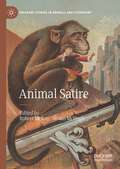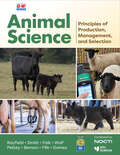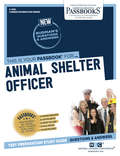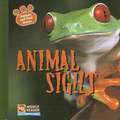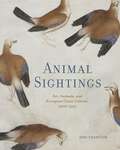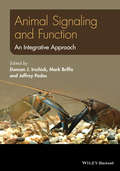- Table View
- List View
Animal Rights: A Historical Anthology
by Linzey Andrew Paul Barry Clarke Eds.This comprehensive and diverse anthology, the only one of its kind, illuminates the complex evolution of moral thought regarding animals and includes writings from ancient Greece to the present. Animal Rights reveals the ways in which a variety of thinkers have addressed such issues as our ethical responsibilities for the welfare of animals, whether animals have rights, and what it means to be human.
Animal Rights: A Historical Anthology
by Linzey Andrew Paul Barry ClarkeIluminates the complex evolution of moral thought regarding animals
Animal Rights: A Reference Handbook
by Clifford J. SherryReviews the issues surrounding animal rights, including experimentation and animal harvesting. Presents the history of the issue, significant federal legislation, and arguments of activists on both sides of the debate. Includes biographical sketches and extensive annotated listings of organizations and print and nonprint resources.
Animal Rights: A Very Short Introduction
by David DegraziaThis volume provides a general overview of the basic ethical and philosophical issues of animal rights. It asks questions such as: Do animals have moral rights? If so, what does this mean? What sorts of mental lives do animals have, and how should we understand welfare? By presenting models for understanding animals' moral status and rights, and examining their mental lives and welfare, David DeGrazia explores the implications for how we should treat animals in connection with our diet, zoos, and research. Animal Rights distinguishes itself by combining intellectual rigor with accessibility, offering a distinct moral voice with a non-polemical tone.
Animal Rights: All That Matters
by Mark RowlandsAnimal Rights is a big deal. From animal testing to vegetarianism, and hunting to preservation of fish stocks, it's a topic that's always in the news. Mark Rowlands, author of The Philosopher and the Wolf, is the world's best known philosopher of animal rights. In this, the first introduction he has written to the topic, he starts by asking whether there is anything about humans that makes us psychologically or physiologically distinctive - so that there might be a moral justification for treating animals in a different way to how we treat humans. From this foundation, he goes on to explore specific issues of eating animals, experimentation, pets, hunting, zoos, predation and engineering animals. He ends with a challenging argument of how an improved understanding of animal ethics can and should affect readers' choices.
Animal Rights: All That Matters (All That Matters)
by Mark RowlandsAnimal Rights is a big deal. From animal testing to vegetarianism, and hunting to preservation of fish stocks, it's a topic that's always in the news. Mark Rowlands, author of The Philosopher and the Wolf, is the world's best known philosopher of animal rights. In this, the first introduction he has written to the topic, he starts by asking whether there is anything about humans that makes us psychologically or physiologically distinctive - so that there might be a moral justification for treating animals in a different way to how we treat humans. From this foundation, he goes on to explore specific issues of eating animals, experimentation, pets, hunting, zoos, predation and engineering animals. He ends with a challenging argument of how an improved understanding of animal ethics can and should affect readers' choices.
Animal Rights: Opposing Viewpoints
by Andrew HarnackEssays giving opposing viewpoints on a variety of topics related to animal rights. Areas include whether animals do in fact have rights, whether animal experimentation is justified, the use of animals for food and other commodities, the protection of wildlife, and unresolved issues within the animal rights movement.
Animal Rights: The Changing Debate
by Robert GarnerDo animals have rights and, if so, what exactly are they? Further, how do these rights relate to human rights? These questions have long bedeviled scientists, philosophers, and animal advocates and today remain as contested as ever. <p><p>Combining the writings of leading academics and activists such as Peter Singer and Michael W. Fox, this anthology examines the development of animal rights discourse over the past quarter century to anticipate the future of the debate. Touching on every aspect of human-animal relations, from agriculture and animal experimentation to the animal rights movement in the United States and abroad, the contributors both question and affirm the utility of the concept of rights. <p><p>Informing this volume is the belief that, regardless of where one stands on the issues of animal rights, it is simply indisputable that how we perceive and treat animals is fundamentally and inextricably related to how we define ourselves.
Animal Rights: the Inhumane Crusade
by Daniel T. OliverA thorough-going discussion and analysis of the animal rights movement, including history, philosophy and tactics. Contains dosiers of prominant figures as well as organizations. Chapter footnotes and bibliography are also included.
Animal Robots (Cool Robots Ser.)
by Erika L. ShoresAnimal robots include everything from a pet dinosaur to a buzzing hummingbird to a floating jellyfish. Find out just what these awesome machines can do.
Animal Sacrifice and the Origins of Islam
by Brannon WheelerIslam is the only biblical religion that still practices animal sacrifice. Indeed, every year more than a million animals are shipped to Mecca from all over the world to be slaughtered during the Muslim Hajj. This multi-disciplinary volume is the first to examine the physical foundations of this practice and the significance of the ritual. Brannon Wheeler uses both textual analysis and various types of material evidence to gain insight into the role of animal sacrifice in Islam. He provides a 'thick description' of the elaborate camel sacrifice performed by Muhammad, which serves as the model for future Hajj sacrifices. Wheeler integrates biblical and classical Arabic sources with evidence from zooarchaeology and the rock art of ancient Arabia to gain insight into an event that reportedly occurred 1400 years ago. His book encourages a more nuanced and expansive conception of “sacrifice” in the history of religion.
Animal Sacrifice in the Ancient Greek World
by Sarah Hitch Ian RutherfordThis volume brings together studies on Greek animal sacrifice by foremost experts in Greek language, literature and material culture. Readers will benefit from the synthesis of new evidence and approaches with a re-evaluation of twentieth-century theories on sacrifice. The chapters range across the whole of antiquity and go beyond the Greek world to consider possible influences in Hittite Anatolia and Egypt, while an introduction to the burgeoning science of osteo-archaeology is provided. The twentieth-century emphasis on sacrifice as part of the Classical Greek polis system is challenged through consideration of various ancient perspectives on sacrifice as distinct from specific political or even Greek contexts. Many previously unexplored topics are covered, particularly the type of animals sacrificed and the spectrum of sacrificial ritual, from libations to lasting memorials of the ritual in art.
Animal Sacrifice, Religion and Law in South Asia (Routledge Religion in Contemporary Asia Series)
by Anthony Good Daniela BertiThis book presents original research on the controversies surrounding animal sacrifice in South Asia through the lens of court cases. It focuses on the parties involved in these cases: on their discourses, motivations, and contrasting points of view. Through an examination of judicial files, court decisions and newspaper articles, and interviews with protagonists, the book explores how the question of animal sacrifice is dealt with through administrative, legislative, and judicial practice. It outlines how, although animal sacrifice has over the ages been contested by various religious reform movements, the practice has remained widespread at all levels of society, especially in certain regions. It reveals that far from merely being a religious and ritual question, animal sacrifice has become a focus of broader public debate, and it discusses how the controversies highlight the contrast between ‘traditional’ and ‘reformist’ understandings of Hinduism; the conflict between the core legal and moral principles of religious freedom and social progress; and the growing concern with environmental issues and animal rights.
Animal Satire (Palgrave Studies in Animals and Literature)
by Susan McHugh Robert McKayAnimal Satire presents a cultural history of animal satire, a critically neglected but persistent presence in the history of cultural production, in which animals expose human folly while the strategies of satire expose the folly of human-animal relations. Highlighting the teeming animal presences across the history of satirical expression from Aristophanes to Twitter, with chapters on key works of literature, drama, film, and a plethora of satirical media, Animal Satire reveals the rich rhetorical significance of animality in powering the politics of satire from ancient and medieval through modern and contemporary times. More pressingly, the book makes the case for the significance of satire for understanding the real-world implications of rhetoric about animals in ongoing struggles for justice. By gathering both critical and creative examples from representative media forms, historical periods, and continents, this volume aims to enrich scholarship on the history of satire as well as empower creative practitioners with ideas about its practical applications today.
Animal Science And Technology class 11 - Maharashtra Board
by Maharashtra State Bureau of Textbook Production and Curriculum ResearchCreated by Maharashtra State Bureau of Textbook Production and Curriculum Research, the text book for class 11 highlights the importance of Indian livestock in the national economy and in the socioeconomic development of the country besides providing food and nutritional security to millions of people. Livestock are the best insurance against the vagaries in nature like draught, famine and other natural calamities. The increasing significance and visible impact of livestock gives stability to agriculture by supplementing family income and generating gainful employment in the rural sector. Thus, livestock provides sustenance to millions of peoples in the vast arid and drought prone area of country. While studying this textbook the section ‘can you recall’ ‘recall a little’ and ‘can you tell’ are used for revision. Many activities given under the titles ‘observe and discuss’ and ‘try this’ ‘use your brain power’ think about it’ etc. will stimulate power of thinking of the students.
Animal Science Reviews 2012
by David HemmingAnimal Science Reviews 2012 provides scientists and students with analysis of key topics in current research including breeding, animal behaviour, zoonotic diseases and environment. Experts such as Mike Stear, James France, Phillip Klesius and Frederick Silversides give essential overviews of their fields. Originally published online in CAB Reviews, this volume makes available in printed form the reviews in animal science published during 2012.
Animal Science and Technology class 12 - Maharashtra Board
by Maharashtra State Bureau of Textbook Production and Curriculum ResearchCreated by the Maharashtra State Bureau of Textbook Production and Curriculum Research, livestock sector plays an important role in Indian economy and is an important sub-sector of Indian Agriculture. Growing population, changing lifestyles, expanding urbanization and hastened climatic changes created new challenges to sustain in the situation. Livestock provides stability to family income especially in the arid and semi-arid regions of the country. Animals are the part of our day-to-day life and contribute for stabilizing the agriculture income particularly when monsoon shows its vagaries. The study of their management from scientific views pays us valuable foods viz. milk, meat and eggs, manures and draft power for our agriculture, hides and bones for the country’s economy. Hence, all such concepts of livestock are explained in this book. Further, the diseases of zoonotic importance and their prevention is also incorporated in this textbook from public health point of view to facilitate the learning of the students in a constructive manner.
Animal Science: Principles Of Production, Management, And Selection
by John S. Rayfield Kasee L. Smith Jeremy Falk Kattlyn Wolf Allen Pettey Drew Parks Benson Jessica Fife Noe Alberto GomezAnimal Science: Principles of Production, Management, and Selection introduces students to the important scientific and applied concepts within the global and domestic animal industries. Serving as an in-depth and hands-on resource for animal science courses, it begins by covering the basics of animal science, including careers, anatomy and physiology, animal health and nutrition, genetics, reproduction, scientific methods, products, and by-products, as well as current issues facing animal scientists. It proceeds with animal-specific sections on beef cattle, swine, sheep, goats, dairy cattle, equine, poultry, and companion animals, each with chapters covering the industry, production, management and care, selection and evaluation, and classification and breeds. Written by an outstanding team of authors who are all current educators with a long history in the animal science industry, this text is up-to-date, well-organized, and extremely image rich with modern, high-quality photos and diagrams. Special features include Before You Read, Did You Know?, Hands-On Animal Science, Safety Notes, Ag Ed Connections, Career Connections, and STEM Connections. It will also serve as a resource and learning tool for programs that don't have a school farm.
Animal Shelter Officer: Passbooks Study Guide (Career Examination Series)
by National Learning CorporationThe Animal Shelter Officer Passbook® prepares you for your test by allowing you to take practice exams in the subjects you need to study. It provides hundreds of questions and answers in the areas that will likely be covered on your upcoming exam, including but not limited to; Care and handling of dogs and other small animals; Clerical aptitude; Understanding and interpreting written material; and more.
Animal Sightings: Art, Animals, and European Court Culture, 1400–1550
by Jodi CranstonAnimal Sightings challenges two common ideas about the depiction of animals in early modern European court art: first, that the human figure relegated animals to peripheral and often symbolic roles, both compositionally and conceptually, and second, that the representation of animals during this period was predominantly tied to a growing interest in naturalism derived from scientific study and discovery. Art historian Jodi Cranston considers the diversity of art representing animals common to that time and place, including dogs, stags, falcons, and even insects. She discusses how early modern European courts (primarily in northern Italy, Tyrol, Saxony, and southern Germany, where the preponderance of European courtly activity related to animals occurred) acquired and kept living animals, sponsored hunts in purpose-cultivated forests, and fostered trade in animal products. The diverse works created by artists associated with those courts reveal an ambivalent and complex view of animals as beings who shared and shaped the world alongside humans. Ultimately, Animal Sightings explores how early modern artists and viewers thought about human-animal interactions, how visual representation facilitated and inhibited knowledge about animals, and how animals could reveal the limits and possibilities of visual representation. It should be of special interest to scholars of early modern studies, art history, and animal studies.
Animal Signaling and Function
by Mark Briffa Duncan J. Irschick Jeffrey PodosThe diversity of animal signals has been widely documented, and the generality of animal signals also tantalizingly suggests that there are common mechanisms that have selected for their origin. However, while much progress has been made on some fronts, we still lack a general theory about why the diversity of signaling structures exist. Our compilation will directly address this gap by focusing on an exciting new arena of sexual selection, namely using functional approaches to understand signaling. This approach is rooted in the idea that many signals are designed to transmit important functional imformation that is both important for issues of male quality (and hence male competition), and female choice. The increasing use of technology in sexual selection studies has enabled researchers to test whether signaling is either constrained by, or accurately transmits information about functional capacities. Further, in animals that fight vigorously, functional capacities such as endurance or strength may make the difference between winning and losing. This volume brings together a diverse collection of researchers who are actively investigating how function and signaling are related. These researchers use both a variety of methods and taxa to study animal signaling, and we believe that this integrative view is important to open up fresh vistas for why animal signals have evolved.
